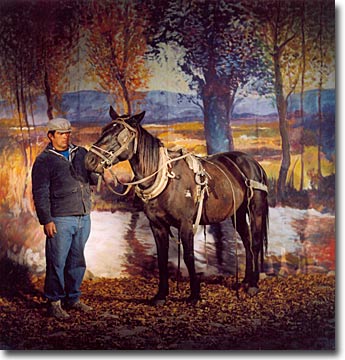Espacio Fundación Telefónica,
Jun 21, 2006 - Aug 20, 2006
Buenos Aires, Argentina
Downey Effect
by María Fernanda Cartagena
In Sombra en un Cerrito of Adriana Bustos several imaginary worlds come into conflict. The cartonero and his horse "contaminate" the tradition of studio photography and of traditional Nineteenth-Century landscapes, thereby presenting an ironical view of the Argentinian imaginary if we consider the idealization of the gaucho and his horse throughout the history of national painting. This monumental "imperial portrait" - a kind of allegory of Argentinian history and its economic crisis-- leads subtly to an analysis of iconography and the gaze similar to the one proposed by Downey in art. Mario Navarro exhibits in Whisky en opsroom the convergence of high technology and local political history through historical documentation (letters, projects and photos) of the surprising initiative for an "Internet" plan designed to control and model a planned economy in Allende’s socialist government. The latter brings out the amplified image of a prototype room belonging to this project. This frustrated experience underscores the conditions in which technology’s social function was developed from other places. Part of Downey’s philosophy was putting technology to work for social purposes: much of his video production was meant to be broadcast through television channels, and the Video Trans America series was a project for exchanging information among cultures. Fredi Casco appropriates the symbolic weight of the manger in order to articulate the impact of technology and mass media upon contemporary subjectivity. He presents the televised image as a new subject of worship and cult and shakes the Christian history of humanity’s origins by evoking cloning. The blind faith of religion seems to compete with one that appears to be more luminous and powerful. Ingrid Wildi, with a personal history of dislocation and dispersion similar to Downey’s, presents Portrait Oblique a video about the splitting of a subaltern subject affected by racial stereotypes and essentialist preconceptions. Using a fixed camera and by means of disquieting questions and answers, he mixes in the fractured biography of his brother. In her work Claudia Casarino has used her body as a social metaphor, and for this show she presents Roundtrip, intimate photographs of her family are projected over white garments in a wardrobe. Technology in this case serves to reveal private histories.
This curatorship (the catalogue is under way) articulates visual approaches from the perspective of different periods and places, which is why it manages to overcome the limitations of a territorially determined perspective. After all, colonialism is global and transnational. The show is also an excellent means of ventilating the historical relationship between technology and power, the dismantling of any inkling of transparency and neutrality. This ambitious exhibition demands much time and dedication on our part; once its effect reaches us, however, it transcends the show, even affecting any sleep-walking zapping we might engage in.
Buenos Aires, August 11, 2006.
-María Fernanda Cartagena
Independent curator, Ph.D. student UBA, editor LatinArt.com
Bibliography :
-ENGUITA Mayo, Nuria; Guardiola Román, Juan and others, Juan Downey: con energía más allá de estos muros, IVAM Centre del Carme, Valencia, 1997 October 28 - 1998 January 1998.
-FOSTER, Hal, "The "Primitive" Unconscious of Modern Art, or White Skin Black Masks", Recordings: Art, Spectacle, Cultural Politics, New York, The New Press, 1999.
-MELLADO, Justo Pastor, "El curador como productor de infraestructura", Material del Primer Foro Internacional de Especialistas e Investigadores en Arte, MAAC, Guayaquil, Ecuador, 4-6 de July, 2001.
-MIGNOLO, Walter D., Historias locales/diseños globales Colonialidad, conocimientos subalternos y pensamientos fronterizo, Madrid, Ediciones Akal, S.A., 2003 (1 Edition in English, 2000).
-SANDLER, Irving, "The Art World of the 1970s", Art of the Postmodern Era: from the late 1960s to the early 1990s, New York, HarperCollins Publishers, Inc., 1996.
Links:
Justo Pastor Mellado.
Juan Downey.
Efecto Downey.
|













